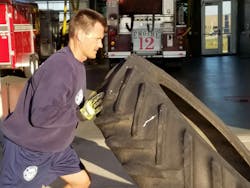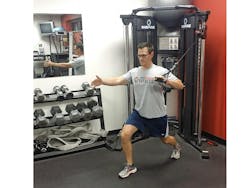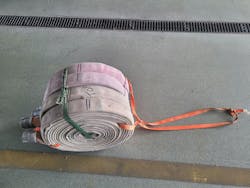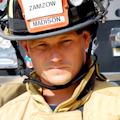Health & Wellness: Essential Fitness Equipment for Firehouses
Maintaining peak physical well-being isn’t a choice for members of the fire service. It’s a prerequisite. The demands of our life-saving profession include maneuvering heavy equipment, lugging hoses and carrying victims away from danger, all of which require sound “functional” fitness levels.
Functional fitness in the fire service has been a talking point for the past 10 years, but what does the term mean? Further, does your workout and the fitness equipment that you have in the station support functional training? What makes an exercise functional for firefighters, EMTs and medics?
To answer these questions, we first must define what functional training means. The definition can be varied and broad; the term often is abused and overused.
Station items = equipment
The best definition of functional training that I found over the years—and one that I believe applies very well to the fire service—was created by the professionals at Mayo Clinic. It identifies functional training as activities for “training the body for the activities performed in daily life.”
In the context of firefighters and first responders, our daily life or shift requires us to lift, carry, push, pull, drag, climb, twist and hoist, all of which are done while we wear restrictive gear and work in unstable planes of motion for prolonged periods of time. This demanding work requires a strong core, mobile and flexible joints, full-body strength and cardiovascular conditioning.
Therefore, for an “exercise” to be functional for a first responder, it must help us to perform in our demanding environment. For a “workout” to be functional, it must promote those components of core and full-body strength, mobility and cardiovascular capacity.
The other component to functional training is the equipment that’s used to resist and perform these functional movements. Twenty years ago, there was a push to get fitness equipment into firehouses to encourage members to work out. At that time, bulky machines that focused on isolation movements (chest fly, leg press, leg extensions) were the rage, and that was what most firehouses purchased.
Based on the definition that’s noted above, we should understand that isolation exercises and selectorized equipment don’t meet the functional demands of the job. Furthermore, although heading to the local gym, with its updated equipment, certainly can be beneficial, having workout equipment right in the firehouse can cater better to our unique functional fitness needs. Unfortunately, sometimes, available budgets and facility space aren’t obtained easily for the much-needed equipment needs.
There is hope, however. Some affordable and highly effective pieces of equipment can help us to maintain our fitness levels even when funds and space are tight. Many of these items already are in and around most firehouses and don’t need budget approval.
The items that are noted below include some staple pieces that are very versatile and functional. Other equipment usually is free or requires minimal investment.
Functional cable column
A cable column is a versatile staple for a firehouse gym. It can be placed in a corner to preserve space, and its variable resistance patterns allow us to replicate fireground movements that transfer to improved performance. These include twisting movements, pulls and presses, all of which can be performed in different stances because of the adjustment capabilities of the system. Pricing varies, but dollar for dollar, the versatility of a cable column makes it one of the biggest “bang for your buck” pieces.
Rowing machines
Cardiovascular fitness is just as vital for firefighters as muscular strength is. Therefore, every firehouse gym should have equipment that’s designed to enhance cardiovascular health. Rowing machines are an ideal all-in-one solution. They provide targeted cardiovascular training that mimics the intense physical demands that are required on the fire/rescue scene.
In addition, rowing machines offer the advantage of having a smaller footprint and delivering greater affordability than treadmills do, which makes a rowing machine a practical investment for firehouse fitness needs.
Medicine balls and kettlebells
Medicine balls and kettlebells are excellent functional training tools. Their range of benefits directly improves performance and functional strength. Their versatility allows for various exercises that target multiple muscle groups simultaneously, thus closely mirroring the varied and unpredictable physical demands that members of the fire service face.
A majority of the exercises that are performed with these tools engage the core muscles. This is critical for maintaining stability and control in varied situations, such as lifting heavy equipment and maneuvering through tight spaces. Additionally, handling medicine balls and kettlebells can enhance grip strength significantly, which is essential for managing hoses, tools and victims during emergency operations.
Medicine ball throws and kettlebell swings/cleans mimic the power movement patterns that correlate to swinging axes and raising ladders. Regular training with medicine balls and kettlebells also enhances balance, coordination and overall strength, which reduces the risk of injuries both on and off the job.
Large tire
One of the most affordable and versatile pieces of equipment that you should add to your firehouse is the trusty large tire. Of course, it usually can be sourced from retired fire apparatus and tractors, and it can be used for a variety of exercises. Some of the most functional of these are tire flips (to build strength and lifting technique), sledges on the tire (to simulate forcible entry) and drags (to simulate hoseline advance and rescue). These dynamic movements not only build strength and power but also target several muscle groups simultaneously, which makes the tire an invaluable asset in our firefighter workout routines.
Webbing
Webbing is valuable not only for rappelling, harnessing and securing equipment but also for fitness training.
By attaching webbing to a heavy object or a weight sled, you can perform drags and pulls, which strengthen the legs and core and enhance cardiovascular endurance and stamina. Webbing also can be attached securely to an apparatus and used as a suspension training system to perform body rows, chest presses, bicep curls and squats.
Firehouse equipment
Other equipment that’s found around the firehouse, such as fire hoses, ladders, foam buckets and rescue dummies, can be repurposed and integrated into workouts.
Old fire hoses, which typically are replaced every few years because of wear and tear, make for excellent fitness tools. Hose bundles are a great way to add additional weight for climbing stairs or for use with webbing to create a drag device.
Ladder carries and raises can be integrated into workouts.
Rescue dummies can be used for drags and carries.
Foam buckets that are filled with water are a great option for use with carries, because the movement of the water during the carry forces the core and stabilizing muscles to work in overdrive.
Creativity & fitness
Maintaining peak physical—and mental—well-being through functional fitness isn’t just beneficial but essential in the fire service. Functional training equips us to perform the demanding tasks of our profession efficiently and safely.
By integrating functional and cost-effective equipment into firehouses, we can foster a culture that improves performance and camaraderie among crews and prolongs careers. Our fitness and health are too important to make excuses. Get creative and find ways to promote a more functionally fit and healthy culture.
Creating a Functional Circuit
A circuit workout is one of the best ways to utilize a cable column, a rowing machine, medicine balls, kettlebells, large tires and webbing in an individual or crew workout. A great template includes choosing three dynamic warm-up movements, including prisoner squats, step-ups and forward toe reaches. Then set up an eight-station circuit. This is where you can get creative and utilize various equipment.
Encourage each member of the crew to choose an exercise or two. Some fitting examples are performing a core movement, such as a plank, sledges on the tire, foam bucket carries, climbing steps with a hose bundle, crawling on the floor, ladder raises and/or medicine ball throws against the wall, and then finishing with a manikin or hose drag. Set up the eight stations and then perform each for 30 seconds. Allow for 30 seconds of rest and transition between stations and challenge yourself and the crew to perform two or three circuits. The total time of the workout, including a short dynamic warm-up and stretching at the end, should be about 30 minutes.
About the Author
Aaron Zamzow
Aaron Zamzow is a firefighter/training officer for Madison, WI, Fire Department. He holds a bachelor’s degree in health/wellness and has 20 years of experience as a fitness trainer. He created Fire Rescue Fitness and authors programs that are aimed at getting fire rescue athletes fit for duty.




